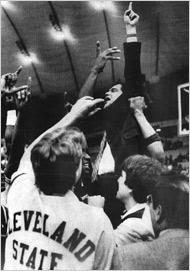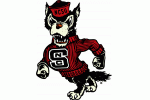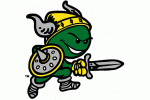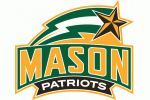 General
General  General Archive
General Archive  Fantasy Bracket: Greatest NCAA Cinderella Runs, Round 3
Fantasy Bracket: Greatest NCAA Cinderella Runs, Round 3
 Two weeks ago, the TCF/STO Cinderella Bracket began by matching up 32 memorable underdog teams from the past 32 years of the Men's NCAA Division I Basketball Tournament. Now, with the rabid, widly enthusiastic participation of online voters like you (or at least a handful of you), the field has been narrowed down to the Elite Eight. So, before you fill out your 2011 tourney bracket looking for that next diamond in the rough, why not find some insights from a revisitation of recent history? These are the eight greatest Cinderella teams to ever bust a bracket.
Two weeks ago, the TCF/STO Cinderella Bracket began by matching up 32 memorable underdog teams from the past 32 years of the Men's NCAA Division I Basketball Tournament. Now, with the rabid, widly enthusiastic participation of online voters like you (or at least a handful of you), the field has been narrowed down to the Elite Eight. So, before you fill out your 2011 tourney bracket looking for that next diamond in the rough, why not find some insights from a revisitation of recent history? These are the eight greatest Cinderella teams to ever bust a bracket.
... Well, they're the eight greatest based on your voting, anyway. Suffice it to say, the Cleveland market doesn't necessarily vote in line with, say, the Bristol crowd. Case in point, your Cleveland State Vikings have managed to advance even further than Kevin Mackey's real-life squad did back in '86, as they shocked Cinderella Tourney favorites Villanova (1985) in the round of sixteen. While the Vikings live on, however, another mighty Northeast Ohio mid-major wasn't so lucky, as the 2002 Kent State Golden Flashes capped a tough week for the KSU community by falling to the top-seeded Butler Bulldogs of 2010. All told, the Elite Eight is pretty well spread out, with 3 teams from the '80s, 2 from the '90s, 2 from the '00s, and 1 from the '70s. When they square off, however, the shortness of their shorts and height of their frontcourt is irrevelant. It's all about the story. Which of these teams truly represents the classic college basketball Cinderella tale in its quintessential form? Can anybody top the storybook N.C. State run of 1983? Did George Mason set the new standard five years ago? Or is Cleveland such a homer town that CSU fans will overcome their 2011 postseason disappointment by annointing a 25 year-old Vikings team with a title all its own?
Again, the teams selected for this tournament only included schools that played in the modern seeding era, 1979-2010. Each team's been given a special seeding for this fake tournament (based on how far they advanced on their Cinderella runs), but their original real-life seedings are also indicated.
Greatest Cinderellas of the NCAA Tournament: Round 3
Dark Horse Regional

 (1) North Carolina State 1983
(1) North Carolina State 1983
vs
(3) Dayton 1984
Match-Up: One thing that became incredibly clear in the round of sixteen is that people don't like to associate big conference programs with the land of the Cinderella. Wisconsin (2000), Kansas (1988), Virginia (1984), and most surprisingly Villanova (1985) all were knocked out last round, leaving North Carolina State as the lone major conference school (ACC) still in the running in the Elite Eight. To get here, Jim Valvano's team survived Steph Curry and Davidson. Now, they'll meet another one of March's all-time PTPers, Dayton's electric Roosevelt Chapman. These two teams were only separated by one year in reality, with Dayton's Elite Eight run coming the season after the Wolfpack's National Title win. In fact, the Flyers may very well have found some extra confidence from having watched just how far a Cinderella could dance one year earlier. In this match-up, though, Dayton should get more of a rude awakening. While they gave it a great effort in '84, N.C. State reached the mountaintop in '83-- ACC though they may be.
North Carolina State 1983
1983 - Seed: #6 / Finish: National Champion
Cinderella Bracket: def. Bradley (2006) and Davidson (2008).
Jim Valvano’s "Cardiac Pack" nearly lost to #11 Pepperdine in Round 1 and narrowly edged #3 Utah and #1 Virginia by one point each. But it was Lorenzo Charles’ buzzer beater over #1 Houston (and the ensuing pandemonium) that has remained an indelible moment in NCAA history.
Dayton 1984
1984 - Seed: #10 / Finish: Elite Eight
Cinderella Bracket: def. Miami of Ohio (1999) and Chattanooga (1997).
Having already ousted #7 LSU, the Flyers became the talk of the tournament when Roosevelt Chapman dropped 41 points in a 89-85 win over #2 Oklahoma. Dayton beat #6 Washington, as well, before running into Patrick Ewing and Georgetown.
Underdog Regional

 (3) Loyola Marymount 1990
(3) Loyola Marymount 1990
vs
(5) Cleveland State 1986
Match-Up: Cleveland State really had no business beating Villanova. The '85 Wildcats are still the lowest seed ever to win a National Championship (#8), and if anything, they had the inside track on trying to stop N.C. State's run to a Cinderella Title. Instead, here come those pesky Vikings again! They've ousted a #1 seed this time, and now they're looking at the winner of the sweet sixteen's emotional battle between Loyola Marymount (1990) and Providence (1987). In the end, people found Loyola's tale of courage and determination to be the more enduring one, and so we've got two "little engines that could" on a direct collision course. Does CSU have enough warm and fuzzy memories in the tank to outlast the inherent drama of the Lions' 1990 run-and-gun miracle run?
Loyola Marymount 1990
1990 - Seed: #11 / Finish: Elite Eight
Cinderella Bracket: def. Lamar (1980) and Providence (1987).
In one of the most emotional storylines not just in the tournament but all sports history, Paul Westhead’s high-octane Lions overcame the tragic death of star Hank Gathers to make an astounding postseason run, crushing #6 New Mexico State and #3 Michigan, and nipping #7 Alabama. Bo Kimble and his teammates ran out of magic against #1 UNLV, but their story still inspires people 20 years later.
Cleveland State 1986
1986 - Seed: #14 / Finish: Sweet Sixteen
Cinderella Bracket: def. Xavier (2004) and Villanova (1985).
For Clevelanders, this legendary CSU squad is practically synonymous with the word Cinderella. Making their NCAA tourney debut, Kevin Mackey’s Summit League champs became the first #14 seed to reach the Sweet Sixteen, knocking off Bob Knight’s #3 Indiana Hoosiers and #6 St. Johns. In the end, only an admiral could stop the Vikings (barely), as David Robinson and Navy prevailed 71-70 in round three.
Longshot Regional
(1) Butler 2010
vs
(3) Penn 1979
Match-up: Along with NC State, Butler is the last #1 seed standing, and they'll likely find themselves in the Final Four next week if for no other reason than their Cinderella run is so fresh in our memories. That said, they're hardly unworthy of the honor. As noted below, the Bulldogs fell just a basket shy of being a near shoe-in for the title of Greatest Cinderella. Had they come out of the Horizon League to be crowned National Champs, who could argue? As it stands, though, there's still plenty of room for debate. Those old enough to remember the way Pennsylvania nearly ran the table 30 years ago will concur. This is especially true when one considers that Penn is one of the few teams in this tournament that was competing primarily against teams with upper classmen and future pros (including Magic Johnson and MSU). Butler's run, while amazing, also came in the era of parity, where Cinderella events are more common and perhaps a tad less awe inspiring.
Butler 2010
2010 - Seed: #5 / Finish: Finals Runner-Up
Cinderella Bracket: def. Richmond (1988) and Kent State (2002).
With a 28-4 record, the Bulldogs were given a decent #5 seed, but they were still a Horizon League school looking up at a glass ceiling. Consider the glass shattered. Butler took down #1 Syracuse, #2 Kansas State, and #5 Michigan State before coming one buzzer beater short of what would have been a monumental National Championship win in their own backyard of Indianapolis.
Pennsylvania 1979
1979 - Seed: #9 / Finish: Final Four
Cinderella Bracket: def. Valparaiso (1998) and Virginia (1984).
In a legendary tournament that ushered in the current seeding system and saw Magic and Bird ignite their rivalry, the amazing run by Pennsylvania gets overlooked. The Ivy League champs took out #1 North Carolina, #4 Syracuse, and #10 St. Johns (a Cinderella in their own right). But Magic Johnson and Michigan State sent the Quakers home in a 101-67 semi-final rout.
Sleeper Regional
(2) George Mason 2006
vs
(4) Gonzaga 1999
Match-up: As we speak, George Mason is hard at work trying to follow the Gonzaga script to annual, mid-major relevancy. And with an 8-seed in the 2011 Tournament, they seem to be well on their way. So, in a battle of teacher vs. student, who has the more impressive resume? Both schools showed they've earned your respect already by eliminating big time opponents last round (Mason over the Final 4 Wisconsin Badgers of 2000 and the Zags over Larry Brown's National Champion Kansas Jayhawks of 1988). In terms of shock value, they're fairly even. George Mason was a #11 seed in '06, while Gonzaga was a #10 in 1999. But when you look at their on-court accomplishments, a favorite starts to emerge. While Gonzaga's three wins came over a so-so #2 seed in Stanford and two fairly low seeds (#6 Florida and #7 Minnesota), Mason's FOUR victories included wins over stud opponents (#3 UNC and #1 Connecticut). Most importantly, though, it's the differing finish lines. The Zags reached the Elite Eight in '99, but George Mason's achievement of reaching the Final Four may still rank as the biggest surprise in tourney history, even above that of Butler reaching the Final four years later.
George Mason 2006
2006 - Seed: #11 / Finish: Final Four
Cinderella Bracket: def. Ball State (1990) and Wisconsin (2000).
Jim Larranaga’s club hadn’t even won the Colonial Athletic conference title (they lost to Hofstra). And when they beat #6 Michigan State, most people still had no clue where George Mason was even located (Fairfax, VA). After the Patriots eliminated #3 North Carolina and #1 Connecticut to reach the Final Four, however, their status was sealed as all-time Cinderella legends.
Gonzaga 1999
1999 - Seed: #10 / Finish: Elite Eight
Cinderella Bracket: def. Missouri (2002) and Kansas (1988).
Before 1999, Gonzaga was known as the alma mater of John Stockton, and that’s about it. Today, they’re a perennial postseason threat, winning at least one tournament game 9 of the last 12 years. It all started in ’99, when the upstart Bulldogs whipped #7 Minnesota, #2 Stanford, and #6 Florida before losing a heartbreaker to top seed and eventual champ Connecticut.
- NBA Announces 2013-2014 Schedule
- Browns Ink Sharknado
- Sharknado A No-Show For Rookie Camp
- Trent Richardson Out Until Training Camp
- Browns Sign Brandon Jackson
- Carrasco Suspended Eight Games
- Browns Add to Wide Receiver Depth with David Nelson
- Browns Need to Learn from Past Draft Mistakes
- Browns Release Chris Gocong and Usama Young
- Browns Missing on Grimes Disappointing, But Not The End
The TCF Forums
- Movies coming out
rebelwithoutaclue (Tuesday, January 21 2014 12:56 PM) - 2015 Recruiting
jclvd_23 (Tuesday, January 21 2014 12:38 PM) - The 2014 Offseason Thread
Larvell Blanks (Tuesday, January 21 2014 12:25 PM) - Official- Browns Coach Search/Rumors
Larvell Blanks (Tuesday, January 21 2014 11:53 AM) - Chris Grant's first 3 drafts
Kingpin74 (Tuesday, January 21 2014 10:13 AM) - Mike Brown
YahooFanChicago (Monday, January 20 2014 11:15 PM) - 2014 Hoops Hockey Hijinx
jpd1224 (Monday, January 20 2014 4:44 PM) - 2014 Recruiting
jclvd_23 (Monday, January 20 2014 2:26 PM) - Wish List - #4 Pick
Hikohadon (Monday, January 20 2014 1:26 PM) - #1 overall pick Anthony Bennett
TouchEmAllTime (Sunday, January 19 2014 1:28 PM)







